24 March 2023
Weekly Market View
The Fed versus markets
US rate cuts are coming – that’s the memo from the markets, even as Fed Chair Powell stuck to his message of remaining focused on curbing inflation despite the banking sector turmoil. Markets are now expecting more than 75bps of rate cuts by the end of the year versus the Fed’s latest projection foreseeing no cuts.
We side more closely with the markets, especially after the recent stresses among small US banks which are likely to tighten bank lending conditions further, even though the liquidity crunch appears to have dissipated for now.
Our US recession indicators, except for two market-based ones – equities and credit spreads – point towards increased risk of a recession this year. That suggests both equities and High Yield bonds are under-pricing recession risks.
Given this, we would continue to rebalance from equities and High Yield bonds, especially in the US, into high grade USD bonds, with a preference for Asia.
Are the US and European financial sectors stabilising after the recent liquidity and confidence boosting measures?
Do you see further downside to US government bonds yields after the latest Fed meeting?
Should we switch away from the CHF as a funding currency?
Charts of the week: Investors are not buying the Fed narrative
Markets are expecting the Fed to cut rates by more than 75bps by the end of this year as the economy enters a recession
Market estimates of Fed rates vs Fed’s own projections
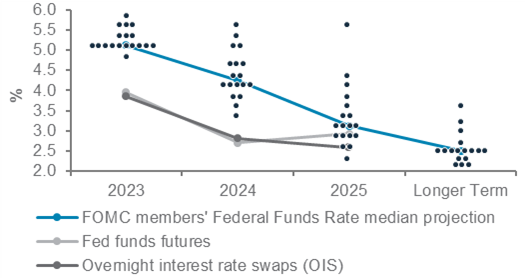
Our recession probability model: Recession in 3m, 6m, 12m
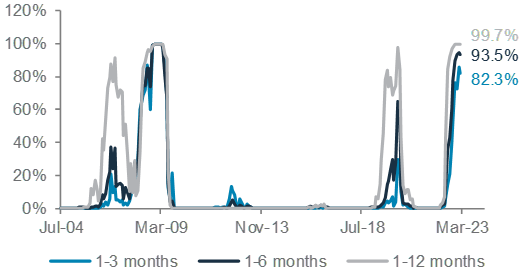
Source: Bloomberg, Standard Chartered
Editorial
The Fed versus markets
US rate cuts are coming – that’s the memo from the markets, even as Fed Chair Powell stuck to his message of remaining focussed on curbing inflation despite the banking sector turmoil. Markets are now expecting more than 75bps of rate cuts by the end of the year versus the Fed’s latest projection (and Powell’s statement) foreseeing no cuts. We side more closely with the markets, especially after the recent stresses among small US banks which are likely to tighten bank lending conditions further, even though the liquidity crunch appears to have dissipated for now. Our US recession indicators, except for two market-based ones (equities and credit spreads), point towards increased risk of a recession this year. That suggests both equities and HY bonds are under-pricing risks. Given this, we would continue to rebalance from equities and HY bonds, especially in the US, into high grade USD bonds, with a preference for Asia.
The message from the Fed this week, as it raised its benchmark rate to a 15-year high of 5.0%, was clear: while the two recent bank failures have tightened financial conditions, the central bank remains focussed on bringing inflation, still running above 5%, back down towards its 2% target. As a result, Fed policymakers are prepared to tighten some more, ending the year with a policy rate of 5.0-5.25%, so that US GDP growth slows to well below the 1.8% long-term trend. The growth slowdown is seen to lift the jobless rate almost 1 percentage points (ppt) to 4.6% by the end of 2024, slightly above the 4% mark that the Fed considers as the long-run optimal jobless rate required to keep inflation in check. Despite these, it expects inflation to fall back closer to its 2% target only by 2025.
The Fed’s benign soft-landing scenario challenges the lessons from the past 60 years, which suggests that when the unemployment rate rises, it usually shoots up at least 2ppt. The median recession since the 1960s, excluding the COVID recession of 2020, resulted in a 3ppt increase in the jobless rate and 1.8ppt decline in GDP, with the recession lasting an average of 10 months. Regardless of the nature of a recession, a downturn seems more imminent than even a month ago. Our quant model is indicating 90% chance of a recession in the next 6 months, with our more subjective view not far behind at 80% in the next 12 months. As a result, the US bond yield curve has steepened (2-year yield has fallen more sharply than 10-year yield) as investors price in rate cuts. Other signals include some early job market indicators, such as the first y/y fall in the hiring of temporary workers and y/y rise in jobless claims in this cycle. A segment of the US yield curve that Powell believes is the best indicator of a coming recession (spread between 3m T-bill yield in 18 months and the current 3m T-bill yield) has fallen to a new record low (below the levels at the onset of 2000 and 2008 recessions). Meanwhile, US money supply is contracting y/y for the first time in history as banks tightened lending conditions significantly even before the current turmoil hit the small banks.
To be sure, US and European authorities have taken forceful measures in recent weeks to reassure bank depositors that their savings are safe. As a result, money market measures of liquidity stress have eased significantly this week. US Treasury Secretary Yellen’s comments suggested that authorities are open to the idea of temporarily guaranteeing all bank deposits at stressed lenders, if not the entire US banking system. Such reassurances and the latest liquidity boost could still lift risk assets in the very near term. However, the challenging 6-12-month outlook argues for investors to fade any such rally.
Investment implications: We remain defensive in our investment stance, preferring to rebalance from equities to income assets, including high grade Developed Market government bonds and Asia USD bonds, which are likely to be more resilient. We see further downside in the USD in the next three months, dragging the USD index (DXY) towards the next support around 100.75. Gold faces strong resistance around USD2,000/oz after a sharp rally, but we would continue to accumulate on any dips due to its safe haven characteristics.
– Rajat Bhattacharya
The weekly macro balance sheet
Our weekly net assessment: On balance, we see the past week’s data and policy as neutral for risk assets in the near term.
(+) factor: Central bank liquidity boost, Credit Suisse rescue
(-) factor: Hawkish central banks, Credit Suisse junior debt write-down before equity
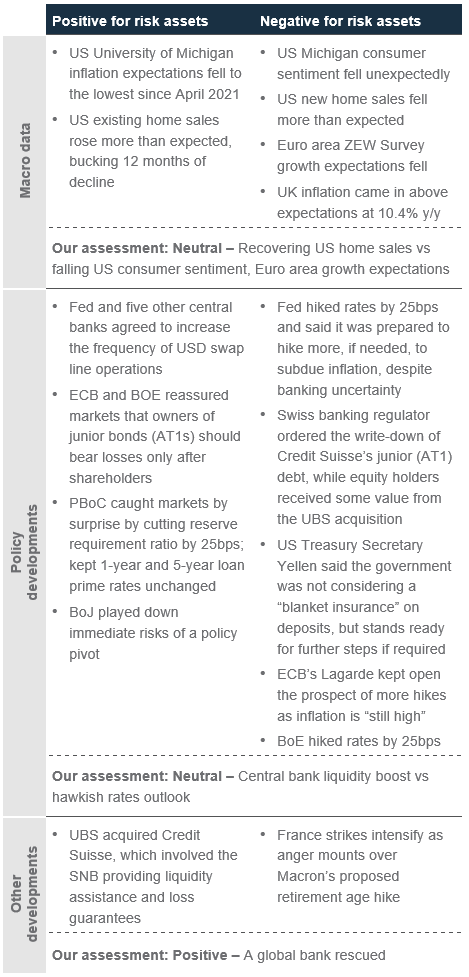
The Fed’s new projections point to slower growth, higher inflation and a higher jobless rate over the next two years and a rate cut only in 2024
The Fed’s new economic projections
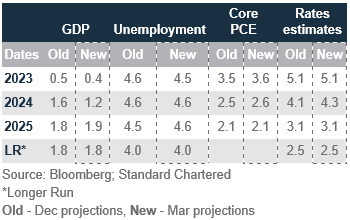
Euro area growth expectations surprisingly fell
Euro area growth expectations and current sentiment, according to ZEW survey
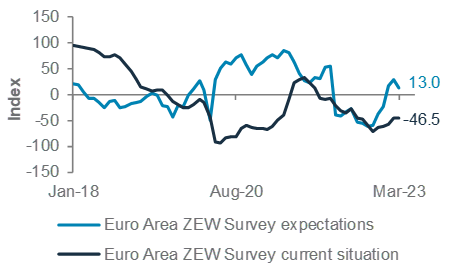
Money markets expect the BoE to keep hiking rates until September, before cutting early next year
Money market estimates of BoE policy rates until 2024
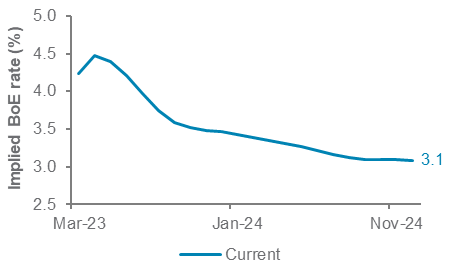
Top client questions
Are the financial sectors in the US and Europe stabilising after the recent liquidity and confidence-boosting measures?
It was yet another volatile week for the banking sector, with the UBS-Credit Suisse merger over the weekend shifting the focus towards the European banking sector. The Swiss regulator’s decision to write down CHF 16bn of Additional Tier-1 (AT1) bonds was the largest such write-down in the relatively short history of the asset class and triggered a sharp knee-jerk reaction. However, we believe that the peak of European banking sector worries are likely behind us.
Over the past few days, authorities from multiple jurisdictions, including the ECB, BoE, MAS and HKMA, have publicly stated that they would respect the hierarchy of the capital structure, indicating that, unlike the SNB, they would impose losses on equity holders before asking bondholders to take losses. These statements boosted market sentiment and we have seen AT1 bond prices recover partially over the past few trading sessions. Arguably, investors will demand an additional risk premium for holding AT1s. While this suggests credit spreads are unlikely to return to early-March levels, we do view today’s yields on the broader high quality financials subordinated debt asset class as attractive and would consider using the opportunity to add exposure.
Meanwhile, credit spreads for senior unsecured bonds for European banks is largely unchanged, indicating limited fears of a full-blown banking sector crisis. In the US, while we believe more work needs to be done to improve confidence in regional banks, we are unlikely to see widespread contagion, given bonds from regional banks account for a very small fraction of the overall universe.
Within financial sector equities, we continue to see an opportunity in the US “mega-large cap” financials sub-sector. Relative to regional banks, they have stronger liquidity profiles and much less exposure to unrealised losses on high-quality assets held to maturity. Many of them have significant retail deposits, which tend to be sticky and are likely to grab market share on the back of this turmoil. M&A activity is beginning to rebound from the current trough in this market, while equity and debt capital markets activity are likely to rebound from historic lows, benefitting “mega-large cap” financials with revenue exposure in these areas.
European financials could face more difficulties in raising capital in the near term given the dent in confidence in the AT1 bond sub-asset class. However, we see strategies that make use of high equity volatility in European financials as more attractive at this time.
— Daniel Lam, Head, Equity Strategy
— Abhilash Narayan, Senior Investment Strategist
Mega-Large Cap banks sold off in sympathy with issues surrounding regional banks
Performance of Mega-Large Cap banks and regional banks, rebased to 100, as of 01-Feb-23
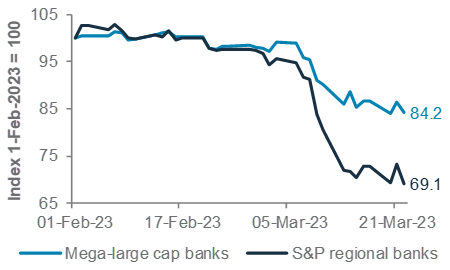
Credit derivatives market signal limited signs of stress in the European Senior bank bond market
iTraxx Senior Financial 5-year CDS spread
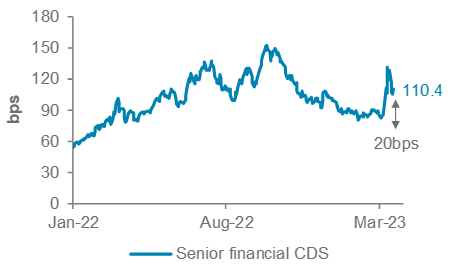
The yield premium on most junior bank debt* is unlikely to return to early-March levels
Yield premium on global bank Contingent Convertible bonds (CoCos)* over US government bonds
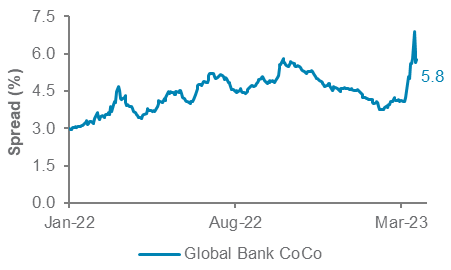
*See explanatory note on page 9
Top client questions (cont’d)
Do you see further downside to US government bond yields after the latest Fed meeting?
The Fed hiked policy rate by another 25bps to 5%, as expected. In its statement, the median Fed Funds target rate for 2023 remained unchanged at 5.125% and the phrase “ongoing increases in interest rate” was dropped and replaced by “some additional policy firming may be needed”. Markets interpreted this as a relatively dovish signal; money markets moved to price the start of rate cuts as soon as September and the US government bond yield curve steepened as the fall in shorter-maturity yields outpaced longer-maturity yields.
Although the fall in the 10-year yield was relatively small (c.10bps), we believe risks continue to be tilted to the downside. First, bond volatility is likely to remain elevated given the recent turbulence in the financial sector. In addition, lending conditions are likely to tighten as regional US banks focus on capital preservation, further tightening overall financial conditions and slowing growth. Third, our macro indicators still point towards a recession ahead. Lastly, technical charts show the 10-year yield remains within the descending channel from March, with support at ~3.4%.
Against this backdrop, we believe adding to high-quality income assets continue to be attractive. We would use any rebound in bond yields as an opportunity to add to our preferred income assets, including Asia USD bonds.
— Cedric Lam, Senior Investment Strategist
The 10Y US government bond yield is testing key support at ~3.4%
US 10-year government bond yield
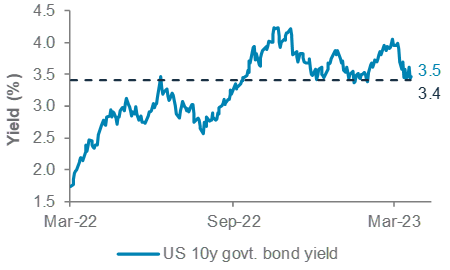
How is China’s corporate earnings season shaping up?
Earning reports in China typically come out later than in the US and Europe. About 60% of the Hang Seng index members have reported earnings for 2022 so far. In aggregate, reported sales and earnings have been lower than expected, following the negative trend seen in companies’ pre-announcements of results. The consensus estimates MSCI China index earnings declined 0.5% in 2022, compared with an expected growth of 1.0% at the start of the year.
However, the outlook for 2023 has nudged up, with 16.6% earnings growth expected vs 14.6% expected at the start of the year. This improvement is observed broadly across 9 out of 11 sectors, underpinned by China’s economic reopening and the removal of mobility restrictions. There are signs of consumption recovery, with consumer services gaining demand and digital advertising improving, although sales of home appliances and consumer electronics linked to the property market are still sluggish. Regulatory pressures in the media and entertainment segments are easing, supporting growth there, while loan growth has accelerated YTD. We expect China’s earnings recovery to continue in 2023, supporting the outperformance of China equities over the next 6-12 months.
— Fook Hien Yap, Senior Investment Strategist
2023 earnings growth expectations in China have nudged up since the start of the year, with improvement seen in 9 out of 11 sectors
Consensus expectations of earnings growth by sectors in MSCI China, as of 1-Jan-2023 and currently
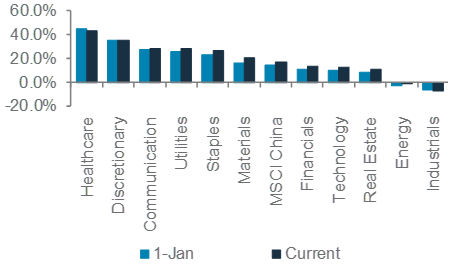
Top client questions (cont’d)
Should we switch away from CHF as a funding currency?
USD/CHF volatility has spiked over the past two weeks following banking system stress in the US and Switzerland. While the Fed chose to hike rates by 25bps, the SNB stuck to a 50bps hike, despite facing greater domestic banking sector scrutiny. In contrast to Fed Chair Powell, SNB President Jordan struck a hawkish tone, guiding towards further rate hikes and indicating that the SNB would be willing to sell FX reserves in order to support the CHF, if necessary.
Given this backdrop, we see a risk of further CHF strength over the next few weeks, with 0.9040 being the key support for USD/CHF. However, CHF gains are likely to prove temporary on a longer 3-12-month horizon. This suggests short-term CHF strength would make it more attractive as a funding currency. Tactically, we also believe USD/JPY looks oversold and risk/reward favours positioning for a move higher should the pair fall below 130, a view we would take with a tight stop-loss at 128.4. Such a move below 130 would make the JPY more attractive as a funding currency.
These views notwithstanding, we would note that (i) FX markets are no longer trending as they were in 2022 and (ii) our bearish 3- and 12-month USD view implies it will become increasingly challenging to find attractive funding currencies, where gains from lower borrowing cost are not offset by borrowing currency strength. Hence, implementing tight stop-losses and maintaining discipline will be key to implementing FX views from a funding perspective.
— Abhilash Narayan, Senior Investment Strategist
CHF is likely to remain supported near-term after the 50bps SNB hike and hawkish guidance
USD/CHF, with key technical levels
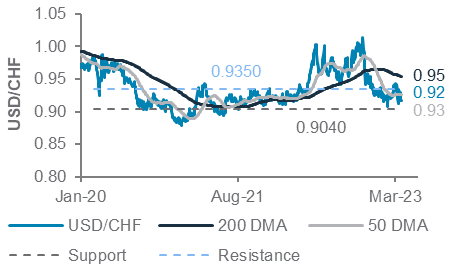
Do you expect further downside in oil prices?
WTI crude oil fell from a high of USD 80.5/bbl to as low as USD 66.7/bbl over the past two weeks. This was likely driven by:
- Risk-off selling triggered by growing concerns over the health of the economy and financial system.
- Reports suggested selling from banks seeking to manage the risks of put options placed by oil producers around USD 70/bbl and USD 75/bbl also were a contributor.
- Trend-following commodity strategies likely accelerated the fall.
- The IEA and OECD both warned about a short-term crude oil surplus due to the resiliency of Russian exports.
Given these drivers, we believe the recent drop is more technical in nature and therefore likely temporary. A blowing over of the banking sector stress is likely to improve risk sentiment. The US Department of Energy is also likely to take advantage of lower prices at some point to replenish the US Strategic Petroleum Reserve (SPR). These suggest prices are likely to bounce back above USD 70/bbl.
— Zhong Liang Han, CFA, Investment Strategist
Oil prices have started to steady after the risk-off drop as the market focus returns to fundamentals
WTI crude oil

Market performance summary*
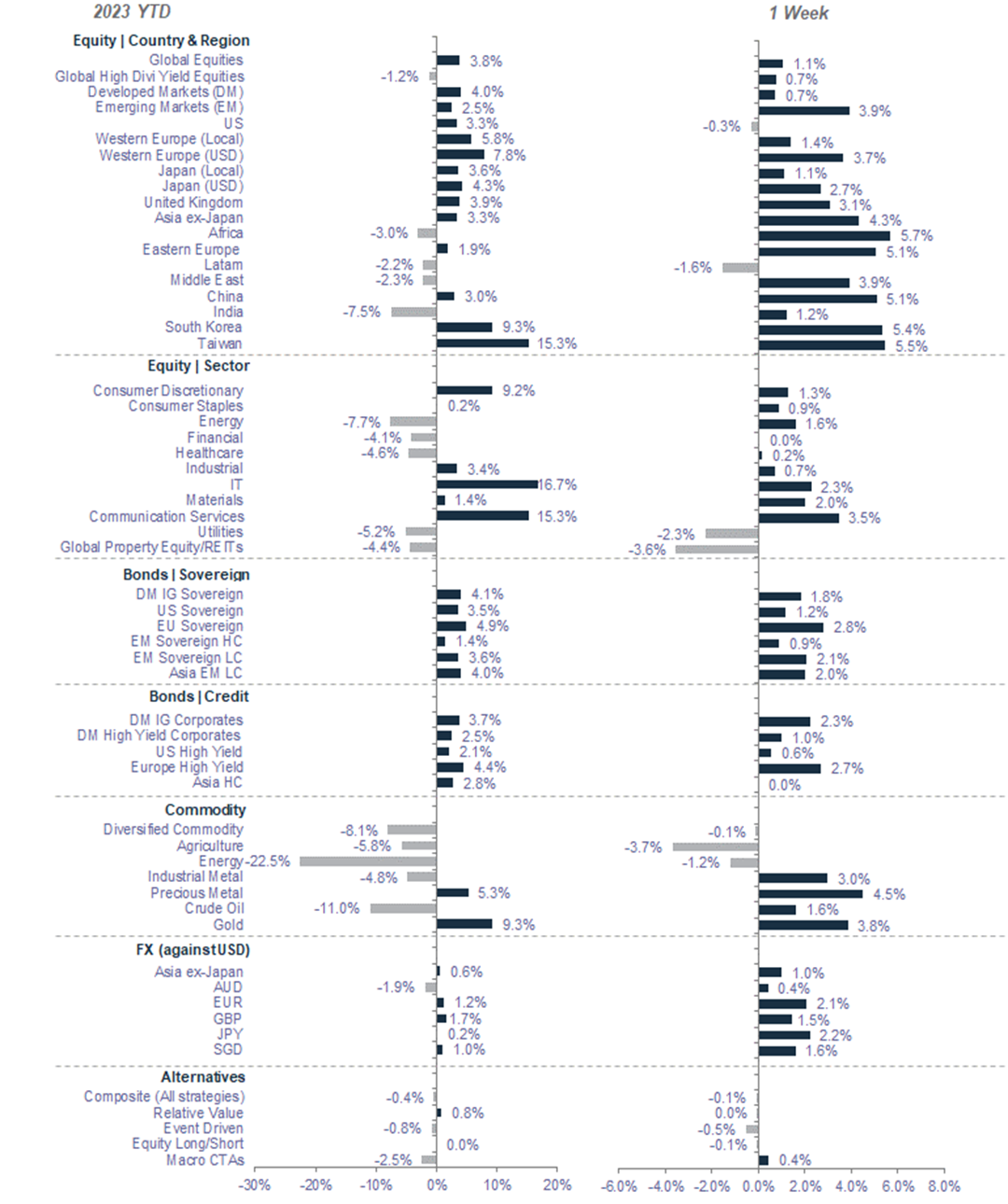
*Performance in USD terms unless otherwise stated, 2023 YTD performance from 31 December 2022 to 23 March 2023; 1-week period: 16 March 2023 to 23 March 2023
Our 12-month asset class views at a glance
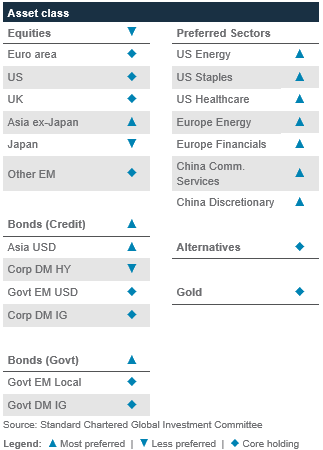
Economic and market calendar
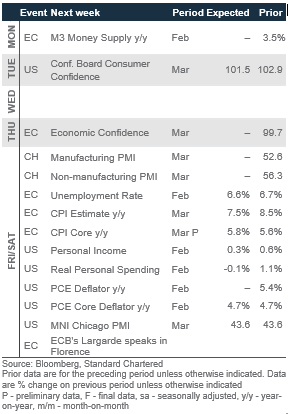
Next support for the US 10-year bond yield is at 3.37%
Technical indicators for key markets as of 23 March close
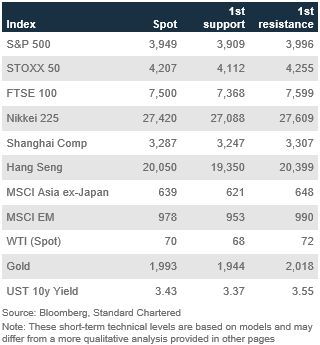
Investor diversity remains healthy across asset classes
Our proprietary market diversity indicators as of 23 March
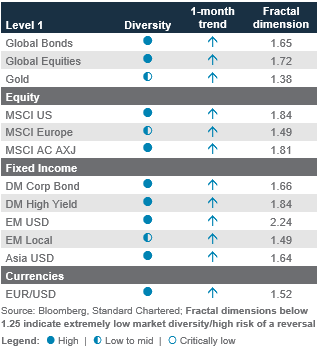
Explanatory notes
*1. Contingent Convertibles are complex financial instruments and are not a suitable or appropriate investment for all investors. This document is not an offer to sell or an invitation to buy any securities or any beneficial interests therein. Contingent convertible securities are not intended to be sold and should not be sold to retail clients in the European Economic Area (EEA) (each as defined in the Policy Statement on the Restrictions on the Retail Distribution of Regulatory Capital Instruments (Feedback to CP14/23 and Final Rules) (“Policy Statement”), read together with the Product Intervention (Contingent Convertible Instruments and Mutual Society Shares) Instrument 2015 (“Instrument”, and together with the Policy Statement, the “Permanent Marketing Restrictions”), which were published by the United Kingdom’s Financial Conduct Authority in June 2015), other than in circumstances that do not give rise to a contravention of the Permanent Marketing Restrictions.
Disclosure
This document is confidential and may also be privileged. If you are not the intended recipient, please destroy all copies and notify the sender immediately. This document is being distributed for general information only and is subject to the relevant disclaimers available at our Standard Chartered website under Regulatory disclosures. It is not and does not constitute research material, independent research, an offer, recommendation or solicitation to enter into any transaction or adopt any hedging, trading or investment strategy, in relation to any securities or other financial instruments. This document is for general evaluation only. It does not take into account the specific investment objectives, financial situation or particular needs of any particular person or class of persons and it has not been prepared for any particular person or class of persons. You should not rely on any contents of this document in making any investment decisions. Before making any investment, you should carefully read the relevant offering documents and seek independent legal, tax and regulatory advice. In particular, we recommend you to seek advice regarding the suitability of the investment product, taking into account your specific investment objectives, financial situation or particular needs, before you make a commitment to purchase the investment product. Opinions, projections and estimates are solely those of SC at the date of this document and subject to change without notice. Past performance is not indicative of future results and no representation or warranty is made regarding future performance. The value of investments, and the income from them, can go down as well as up, and you may not recover the amount of your original investment. You are not certain to make a profit and may lose money. Any forecast contained herein as to likely future movements in rates or prices or likely future events or occurrences constitutes an opinion only and is not indicative of actual future movements in rates or prices or actual future events or occurrences (as the case may be). This document must not be forwarded or otherwise made available to any other person without the express written consent of the Standard Chartered Group (as defined below). Standard Chartered Bank is incorporated in England with limited liability by Royal Charter 1853 Reference Number ZC18. The Principal Office of the Company is situated in England at 1 Basinghall Avenue, London, EC2V 5DD. Standard Chartered Bank is authorised by the Prudential Regulation Authority and regulated by the Financial Conduct Authority and Prudential Regulation Authority. Standard Chartered PLC, the ultimate parent company of Standard Chartered Bank, together with its subsidiaries and affiliates (including each branch or representative office), form the Standard Chartered Group. Standard Chartered Private Bank is the private banking division of Standard Chartered. Private banking activities may be carried out internationally by different legal entities and affiliates within the Standard Chartered Group (each an “SC Group Entity”) according to local regulatory requirements. Not all products and services are provided by all branches, subsidiaries and affiliates within the Standard Chartered Group. Some of the SC Group Entities only act as representatives of Standard Chartered Private Bank and may not be able to offer products and services or offer advice to clients.
Copyright © 2025, Accounting Research & Analytics, LLC d/b/a CFRA (and its affiliates, as applicable). Reproduction of content provided by CFRA in any form is prohibited except with the prior written permission of CFRA. CFRA content is not investment advice and a reference to or observation concerning a security or investment provided in the CFRA SERVICES is not a recommendation to buy, sell or hold such investment or security or make any other investment decisions. The CFRA content contains opinions of CFRA based upon publicly-available information that CFRA believes to be reliable and the opinions are subject to change without notice. This analysis has not been submitted to, nor received approval from, the United States Securities and Exchange Commission or any other regulatory body. While CFRA exercised due care in compiling this analysis, CFRA, ITS THIRD-PARTY SUPPLIERS, AND ALL RELATED ENTITIES SPECIFICALLY DISCLAIM ALL WARRANTIES, EXPRESS OR IMPLIED, INCLUDING, BUT NOT LIMITED TO, ANY WARRANTIES OF MERCHANTABILITY OR FITNESS FOR A PARTICULAR PURPOSE OR USE, to the full extent permitted by law, regarding the accuracy, completeness, or usefulness of this information and assumes no liability with respect to the consequences of relying on this information for investment or other purposes. No content provided by CFRA (including ratings, credit-related analyses and data, valuations, model, software or other application or output therefrom) or any part thereof may be modified, reverse engineered, reproduced or distributed in any form by any means, or stored in a database or retrieval system, without the prior written permission of CFRA, and such content shall not be used for any unlawful or unauthorized purposes. CFRA and any third-party providers, as well as their directors, officers, shareholders, employees or agents do not guarantee the accuracy, completeness, timeliness or availability of such content. In no event shall CFRA, its affiliates, or their third-party suppliers be liable for any direct, indirect, special, or consequential damages, costs, expenses, legal fees, or losses (including lost income or lost profit and opportunity costs) in connection with a subscriber’s, subscriber’s customer’s, or other’s use of CFRA’s content.
Market Abuse Regulation (MAR) Disclaimer
Banking activities may be carried out internationally by different branches, subsidiaries and affiliates within the Standard Chartered Group according to local regulatory requirements. Opinions may contain outright “buy”, “sell”, “hold” or other opinions. The time horizon of this opinion is dependent on prevailing market conditions and there is no planned frequency for updates to the opinion. This opinion is not independent of Standard Chartered Group’s trading strategies or positions. Standard Chartered Group and/or its affiliates or its respective officers, directors, employee benefit programmes or employees, including persons involved in the preparation or issuance of this document may at any time, to the extent permitted by applicable law and/or regulation, be long or short any securities or financial instruments referred to in this document or have material interest in any such securities or related investments. Therefore, it is possible, and you should assume, that Standard Chartered Group has a material interest in one or more of the financial instruments mentioned herein. Please refer to our Standard Chartered website under Regulatory disclosures for more detailed disclosures, including past opinions/ recommendations in the last 12 months and conflict of interests, as well as disclaimers. A covering strategist may have a financial interest in the debt or equity securities of this company/issuer. All covering strategist are licensed to provide investment recommendations under Monetary Authority of Singapore or Hong Kong Monetary Authority. This document must not be forwarded or otherwise made available to any other person without the express written consent of Standard Chartered Group.
Sustainable Investments
Any ESG data used or referred to has been provided by Morningstar, Sustainalytics, MSCI or Bloomberg. Refer to 1) Morningstar website under Sustainable Investing, 2) Sustainalytics website under ESG Risk Ratings, 3) MCSI website under ESG Business Involvement Screening Research and 4) Bloomberg green, social & sustainability bonds guide for more information. The ESG data is as at the date of publication based on data provided, is for informational purpose only and is not warranted to be complete, timely, accurate or suitable for a particular purpose, and it may be subject to change. Sustainable Investments (SI): This refers to funds that have been classified as ‘Sustainable Investments’ by Morningstar. SI funds have explicitly stated in their prospectus and regulatory filings that they either incorporate ESG factors into the investment process or have a thematic focus on the environment, gender diversity, low carbon, renewable energy, water or community development. For equity, it refers to shares/stocks issued by companies with Sustainalytics ESG Risk Rating of Low/Negligible. For bonds, it refers to debt instruments issued by issuers with Sustainalytics ESG Risk Rating of Low/Negligible, and/or those being certified green, social, sustainable bonds by Bloomberg. For structured products, it refers to products that are issued by any issuer who has a Sustainable Finance framework that aligns with Standard Chartered’s Green and Sustainable Product Framework, with underlying assets that are part of the Sustainable Investment universe or separately approved by Standard Chartered’s Sustainable Finance Governance Committee. Sustainalytics ESG risk ratings shown are factual and are not an indicator that the product is classified or marketed as “green”, “sustainable” or similar under any particular classification system or framework.
Country/Market Specific Disclosures
Botswana: This document is being distributed in Botswana by, and is attributable to, Standard Chartered Bank Botswana Limited which is a financial institution licensed under the Section 6 of the Banking Act CAP 46.04 and is listed in the Botswana Stock Exchange. Brunei Darussalam: This document is being distributed in Brunei Darussalam by, and is attributable to, Standard Chartered Bank (Brunei Branch) | Registration Number RFC/61 and Standard Chartered Securities (B) Sdn Bhd | Registration Number RC20001003. Standard Chartered Bank is incorporated in England with limited liability by Royal Charter 1853 Reference Number ZC18. Standard Chartered Securities (B) Sdn Bhd is a limited liability company registered with the Registry of Companies with Registration Number RC20001003 and licensed by Brunei Darussalam Central Bank as a Capital Markets Service License Holder with License Number BDCB/R/CMU/S3-CL and it is authorised to conduct Islamic investment business through an Islamic window. China Mainland: This document is being distributed in China by, and is attributable to, Standard Chartered Bank (China) Limited which is mainly regulated by National Financial Regulatory Administration (NFRA), State Administration of Foreign Exchange (SAFE), and People’s Bank of China (PBOC). Hong Kong: In Hong Kong, this document, except for any portion advising on or facilitating any decision on futures contracts trading, is distributed by Standard Chartered Bank (Hong Kong) Limited (“SCBHK”), a subsidiary of Standard Chartered PLC. SCBHK has its registered address at 32/F, Standard Chartered Bank Building, 4-4A Des Voeux Road Central, Hong Kong and is regulated by the Hong Kong Monetary Authority and registered with the Securities and Futures Commission (“SFC”) to carry on Type 1 (dealing in securities), Type 4 (advising on securities), Type 6 (advising on corporate finance) and Type 9 (asset management) regulated activity under the Securities and Futures Ordinance (Cap. 571) (“SFO”) (CE No. AJI614). The contents of this document have not been reviewed by any regulatory authority in Hong Kong and you are advised to exercise caution in relation to any offer set out herein. If you are in doubt about any of the contents of this document, you should obtain independent professional advice. Any product named herein may not be offered or sold in Hong Kong by means of any document at any time other than to “professional investors” as defined in the SFO and any rules made under that ordinance. In addition, this document may not be issued or possessed for the purposes of issue, whether in Hong Kong or elsewhere, and any interests may not be disposed of, to any person unless such person is outside Hong Kong or is a “professional investor” as defined in the SFO and any rules made under that ordinance, or as otherwise may be permitted by that ordinance. In Hong Kong, Standard Chartered Private Bank is the private banking division of SCBHK, a subsidiary of Standard Chartered PLC. Ghana: Standard Chartered Bank Ghana Limited accepts no liability and will not be liable for any loss or damage arising directly or indirectly (including special, incidental or consequential loss or damage) from your use of these documents. Past performance is not indicative of future results and no representation or warranty is made regarding future performance. You should seek advice from a financial adviser on the suitability of an investment for you, taking into account these factors before making a commitment to invest in an investment. To unsubscribe from receiving further updates, please send an email to feedback.ghana@sc.com. Please do not reply to this email. Call our Priority Banking on 0302610750 for any questions or service queries. You are advised not to send any confidential and/or important information to Standard Chartered via e-mail, as Standard Chartered makes no representations or warranties as to the security or accuracy of any information transmitted via e-mail. Standard Chartered shall not be responsible for any loss or damage suffered by you arising from your decision to use e-mail to communicate with the Bank. India: This document is being distributed in India by Standard Chartered in its capacity as a distributor of mutual funds and referrer of any other third party financial products. Standard Chartered does not offer any ‘Investment Advice’ as defined in the Securities and Exchange Board of India (Investment Advisers) Regulations, 2013 or otherwise. Services/products related securities business offered by Standard Charted are not intended for any person, who is a resident of any jurisdiction, the laws of which imposes prohibition on soliciting the securities business in that jurisdiction without going through the registration requirements and/or prohibit the use of any information contained in this document. Indonesia: This document is being distributed in Indonesia by Standard Chartered Bank, Indonesia branch, which is a financial institution licensed and supervised by Otoritas Jasa Keuangan (Financial Service Authority) and Bank Indonesia. Jersey: In Jersey, Standard Chartered Private Bank is the Registered Business Name of the Jersey Branch of Standard Chartered Bank. The Jersey Branch of Standard Chartered Bank is regulated by the Jersey Financial Services Commission. Copies of the latest audited accounts of Standard Chartered Bank are available from its principal place of business in Jersey: PO Box 80, 15 Castle Street, St Helier, Jersey JE4 8PT. Standard Chartered Bank is incorporated in England with limited liability by Royal Charter in 1853 Reference Number ZC 18. The Principal Office of the Company is situated in England at 1 Basinghall Avenue, London, EC2V 5DD. Standard Chartered Bank is authorised by the Prudential Regulation Authority and regulated by the Financial Conduct Authority and Prudential Regulation Authority. The Jersey Branch of Standard Chartered Bank is also an authorised financial services provider under license number 44946 issued by the Financial Sector Conduct Authority of the Republic of South Africa. Jersey is not part of the United Kingdom and all business transacted with Standard Chartered Bank, Jersey Branch and other SC Group Entity outside of the United Kingdom, are not subject to some or any of the investor protection and compensation schemes available under United Kingdom law. Kenya: This document is being distributed in Kenya by and is attributable to Standard Chartered Bank Kenya Limited. Investment Products and Services are distributed by Standard Chartered Investment Services Limited, a wholly owned subsidiary of Standard Chartered Bank Kenya Limited that is licensed by the Capital Markets Authority in Kenya, as a Fund Manager. Standard Chartered Bank Kenya Limited is regulated by the Central Bank of Kenya. Malaysia: This document is being distributed in Malaysia by Standard Chartered Bank Malaysia Berhad (“SCBMB”). Recipients in Malaysia should contact SCBMB in relation to any matters arising from, or in connection with, this document. This document has not been reviewed by the Securities Commission Malaysia. The product lodgement, registration, submission or approval by the Securities Commission of Malaysia does not amount to nor indicate recommendation or endorsement of the product, service or promotional activity. Investment products are not deposits and are not obligations of, not guaranteed by, and not protected by SCBMB or any of the affiliates or subsidiaries, or by Perbadanan Insurans Deposit Malaysia, any government or insurance agency. Investment products are subject to investment risks, including the possible loss of the principal amount invested. SCBMB expressly disclaim any liability and responsibility for any loss arising directly or indirectly (including special, incidental or consequential loss or damage) arising from the financial losses of the Investment Products due to market condition. Nigeria: This document is being distributed in Nigeria by Standard Chartered Bank Nigeria Limited (SCB Nigeria), a bank duly licensed and regulated by the Central Bank of Nigeria. SCB Nigeria accepts no liability for any loss or damage arising directly or indirectly (including special, incidental or consequential loss or damage) from your use of these documents. You should seek advice from a financial adviser on the suitability of an investment for you, taking into account these factors before making a commitment to invest in an investment. To unsubscribe from receiving further updates, please send an email to clientcare.ng@sc.com requesting to be removed from our mailing list. Please do not reply to this email. Call our Priority Banking on 02 012772514 for any questions or service queries. SCB Nigeria shall not be responsible for any loss or damage arising from your decision to send confidential and/or important information to Standard Chartered via e-mail. SCB Nigeria makes no representations or warranties as to the security or accuracy of any information transmitted via e-mail. Pakistan: This document is being distributed in Pakistan by, and attributable to Standard Chartered Bank (Pakistan) Limited having its registered office at PO Box 5556, I.I Chundrigar Road Karachi, which is a banking company registered with State Bank of Pakistan under Banking Companies Ordinance 1962 and is also having licensed issued by Securities & Exchange Commission of Pakistan for Security Advisors. Standard Chartered Bank (Pakistan) Limited acts as a distributor of mutual funds and referrer of other third-party financial products. Singapore: This document is being distributed in Singapore by, and is attributable to, Standard Chartered Bank (Singapore) Limited (Registration No. 201224747C/ GST Group Registration No. MR-8500053-0, “SCBSL”). Recipients in Singapore should contact SCBSL in relation to any matters arising from, or in connection with, this document. SCBSL is an indirect wholly owned subsidiary of Standard Chartered Bank and is licensed to conduct banking business in Singapore under the Singapore Banking Act, 1970. Standard Chartered Private Bank is the private banking division of SCBSL. IN RELATION TO ANY SECURITY OR SECURITIES-BASED DERIVATIVES CONTRACT REFERRED TO IN THIS DOCUMENT, THIS DOCUMENT, TOGETHER WITH THE ISSUER DOCUMENTATION, SHALL BE DEEMED AN INFORMATION MEMORANDUM (AS DEFINED IN SECTION 275 OF THE SECURITIES AND FUTURES ACT, 2001 (“SFA”)). THIS DOCUMENT IS INTENDED FOR DISTRIBUTION TO ACCREDITED INVESTORS, AS DEFINED IN SECTION 4A(1)(a) OF THE SFA, OR ON THE BASIS THAT THE SECURITY OR SECURITIES-BASED DERIVATIVES CONTRACT MAY ONLY BE ACQUIRED AT A CONSIDERATION OF NOT LESS THAN S$200,000 (OR ITS EQUIVALENT IN A FOREIGN CURRENCY) FOR EACH TRANSACTION. Further, in relation to any security or securities-based derivatives contract, neither this document nor the Issuer Documentation has been registered as a prospectus with the Monetary Authority of Singapore under the SFA. Accordingly, this document and any other document or material in connection with the offer or sale, or invitation for subscription or purchase, of the product may not be circulated or distributed, nor may the product be offered or sold, or be made the subject of an invitation for subscription or purchase, whether directly or indirectly, to persons other than a relevant person pursuant to section 275(1) of the SFA, or any person pursuant to section 275(1A) of the SFA, and in accordance with the conditions specified in section 275 of the SFA, or pursuant to, and in accordance with the conditions of, any other applicable provision of the SFA. In relation to any collective investment schemes referred to in this document, this document is for general information purposes only and is not an offering document or prospectus (as defined in the SFA). This document is not, nor is it intended to be (i) an offer or solicitation of an offer to buy or sell any capital markets product; or (ii) an advertisement of an offer or intended offer of any capital markets product. Deposit Insurance Scheme: Singapore dollar deposits of non-bank depositors are insured by the Singapore Deposit Insurance Corporation, for up to S$100,000 in aggregate per depositor per Scheme member by law. Foreign currency deposits, dual currency investments, structured deposits and other investment products are not insured. This advertisement has not been reviewed by the Monetary Authority of Singapore. Taiwan: SC Group Entity or Standard Chartered Bank (Taiwan) Limited (“SCB (Taiwan)”) may be involved in the financial instruments contained herein or other related financial instruments. The author of this document may have discussed the information contained herein with other employees or agents of SC or SCB (Taiwan). The author and the above-mentioned employees of SC or SCB (Taiwan) may have taken related actions in respect of the information involved (including communication with customers of SC or SCB (Taiwan) as to the information contained herein). The opinions contained in this document may change, or differ from the opinions of employees of SC or SCB (Taiwan). SC and SCB (Taiwan) will not provide any notice of any changes to or differences between the above-mentioned opinions. This document may cover companies with which SC or SCB (Taiwan) seeks to do business at times and issuers of financial instruments. Therefore, investors should understand that the information contained herein may serve as specific purposes as a result of conflict of interests of SC or SCB (Taiwan). SC, SCB (Taiwan), the employees (including those who have discussions with the author) or customers of SC or SCB (Taiwan) may have an interest in the products, related financial instruments or related derivative financial products contained herein; invest in those products at various prices and on different market conditions; have different or conflicting interests in those products. The potential impacts include market makers’ related activities, such as dealing, investment, acting as agents, or performing financial or consulting services in relation to any of the products referred to in this document. UAE: DIFC – Standard Chartered Bank is incorporated in England with limited liability by Royal Charter 1853 Reference Number ZC18.The Principal Office of the Company is situated in England at 1 Basinghall Avenue, London, EC2V 5DD. Standard Chartered Bank is authorised by the Prudential Regulation Authority and regulated by the Financial Conduct Authority and Prudential Regulation Authority. Standard Chartered Bank, Dubai International Financial Centre having its offices at Dubai International Financial Centre, Building 1, Gate Precinct, P.O. Box 999, Dubai, UAE is a branch of Standard Chartered Bank and is regulated by the Dubai Financial Services Authority (“DFSA”). This document is intended for use only by Professional Clients and is not directed at Retail Clients as defined by the DFSA Rulebook. In the DIFC we are authorised to provide financial services only to clients who qualify as Professional Clients and Market Counterparties and not to Retail Clients. As a Professional Client you will not be given the higher retail client protection and compensation rights and if you use your right to be classified as a Retail Client we will be unable to provide financial services and products to you as we do not hold the required license to undertake such activities. For Islamic transactions, we are acting under the supervision of our Shariah Supervisory Committee. Relevant information on our Shariah Supervisory Committee is currently available on the Standard Chartered Bank website in the Islamic banking section. For residents of the UAE – Standard Chartered Bank UAE does not provide financial analysis or consultation services in or into the UAE within the meaning of UAE Securities and Commodities Authority Decision No. 48/r of 2008 concerning financial consultation and financial analysis. Uganda: Our Investment products and services are distributed by Standard Chartered Bank Uganda Limited, which is licensed by the Capital Markets Authority as an investment adviser. United Kingdom: In the UK, Standard Chartered Bank is authorised by the Prudential Regulation Authority and regulated by the Financial Conduct Authority and Prudential Regulation Authority. This communication has been approved by Standard Chartered Bank for the purposes of Section 21 (2) (b) of the United Kingdom’s Financial Services and Markets Act 2000 (“FSMA”) as amended in 2010 and 2012 only. Standard Chartered Bank (trading as Standard Chartered Private Bank) is also an authorised financial services provider (license number 45747) in terms of the South African Financial Advisory and Intermediary Services Act, 2002. The Materials have not been prepared in accordance with UK legal requirements designed to promote the independence of investment research, and that it is not subject to any prohibition on dealing ahead of the dissemination of investment research. Vietnam: This document is being distributed in Vietnam by, and is attributable to, Standard Chartered Bank (Vietnam) Limited which is mainly regulated by State Bank of Vietnam (SBV). Recipients in Vietnam should contact Standard Chartered Bank (Vietnam) Limited for any queries regarding any content of this document. Zambia: This document is distributed by Standard Chartered Bank Zambia Plc, a company incorporated in Zambia and registered as a commercial bank and licensed by the Bank of Zambia under the Banking and Financial Services Act Chapter 387 of the Laws of Zambia.
